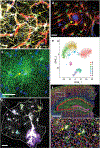Reactive astrocyte nomenclature, definitions, and future directions
- PMID: 33589835
- PMCID: PMC8007081
- DOI: 10.1038/s41593-020-00783-4
Reactive astrocyte nomenclature, definitions, and future directions
Abstract
Reactive astrocytes are astrocytes undergoing morphological, molecular, and functional remodeling in response to injury, disease, or infection of the CNS. Although this remodeling was first described over a century ago, uncertainties and controversies remain regarding the contribution of reactive astrocytes to CNS diseases, repair, and aging. It is also unclear whether fixed categories of reactive astrocytes exist and, if so, how to identify them. We point out the shortcomings of binary divisions of reactive astrocytes into good-vs-bad, neurotoxic-vs-neuroprotective or A1-vs-A2. We advocate, instead, that research on reactive astrocytes include assessment of multiple molecular and functional parameters-preferably in vivo-plus multivariate statistics and determination of impact on pathological hallmarks in relevant models. These guidelines may spur the discovery of astrocyte-based biomarkers as well as astrocyte-targeting therapies that abrogate detrimental actions of reactive astrocytes, potentiate their neuro- and glioprotective actions, and restore or augment their homeostatic, modulatory, and defensive functions.
Figures


Similar articles
-
Temporal Profiling of Astrocyte Precursors Reveals Parallel Roles for Asef during Development and after Injury.J Neurosci. 2016 Nov 23;36(47):11904-11917. doi: 10.1523/JNEUROSCI.1658-16.2016. J Neurosci. 2016. PMID: 27881777 Free PMC article.
-
Inhibition of A1 Astrocytes and Activation of A2 Astrocytes for the Treatment of Spinal Cord Injury.Neurochem Res. 2023 Mar;48(3):767-780. doi: 10.1007/s11064-022-03820-9. Epub 2022 Nov 23. Neurochem Res. 2023. PMID: 36418652 Review.
-
Astrocyte subtype-specific approach to Alzheimer's disease treatment.Neurochem Int. 2021 May;145:104956. doi: 10.1016/j.neuint.2021.104956. Epub 2021 Jan 24. Neurochem Int. 2021. PMID: 33503465 Review.
-
Heterogeneity analysis of astrocytes following spinal cord injury at single-cell resolution.FASEB J. 2022 Aug;36(8):e22442. doi: 10.1096/fj.202200463R. FASEB J. 2022. PMID: 35816276
-
The dual role of astrocyte activation and reactive gliosis.Neurosci Lett. 2014 Apr 17;565:30-8. doi: 10.1016/j.neulet.2013.12.071. Epub 2014 Jan 7. Neurosci Lett. 2014. PMID: 24406153 Review.
Cited by
-
Mechanisms and Therapeutic Prospects of Microglia-Astrocyte Interactions in Neuropathic Pain Following Spinal Cord Injury.Mol Neurobiol. 2024 Oct 29. doi: 10.1007/s12035-024-04562-1. Online ahead of print. Mol Neurobiol. 2024. PMID: 39470872 Review.
-
Nerve agent exposure and physiological stress alter brain microstructure and immune profiles after inflammatory challenge in a long-term rat model of Gulf War Illness.Brain Behav Immun Health. 2024 Sep 30;42:100878. doi: 10.1016/j.bbih.2024.100878. eCollection 2024 Dec. Brain Behav Immun Health. 2024. PMID: 39430882 Free PMC article.
-
Inflammaging and Brain Aging.Int J Mol Sci. 2024 Sep 30;25(19):10535. doi: 10.3390/ijms251910535. Int J Mol Sci. 2024. PMID: 39408862 Free PMC article. Review.
-
A Systematic Review of Delta-9-Tetrahydrocannabinol (∆9-THC) in Astrocytic Markers.Cells. 2024 Sep 29;13(19):1628. doi: 10.3390/cells13191628. Cells. 2024. PMID: 39404391 Free PMC article. Review.
-
Astrocytic DLL4-NOTCH1 signaling pathway promotes neuroinflammation via the IL-6-STAT3 axis.J Neuroinflammation. 2024 Oct 10;21(1):258. doi: 10.1186/s12974-024-03246-w. J Neuroinflammation. 2024. PMID: 39390606 Free PMC article.
References
-
- Virchow R Cellular Pathology (De Witt Robert M., 1860).
-
- Achucarro N Some pathological findings in the neuroglia and in the ganglion cells of the cortex in senile conditions. Bull. Gov. Hosp. Insane 2, 81–90 (1910).
-
-
Andriezen WL The neuroglia elements in the human brain. Brit. Med. J 2, 227–230 (1893).
The first account of hypertrophic reactive astrocytes in pathology, although they were not called hypertrophic or reactive astrocytes.
-
-
- Weigert C Beiträge zur Kenntnis der normalen menschlichen Neuroglia. in Zeitschrift für Psychologie und Physiologie der Sinnesorgane (Moritz Diesterweg, 1895).
-
- Del Río-Hortega P & Penfield WG Cerebral cicatrix: The reaction of neuroglia and microglia to brain wounds. Bull. Johns Hopkins Hosp. 41, 278–303 (1927).
Publication types
MeSH terms
Grants and funding
- R01 NS110690/NS/NINDS NIH HHS/United States
- RF1 AG027297/AG/NIA NIH HHS/United States
- R01 AG066171/AG/NIA NIH HHS/United States
- R56 AG060974/AG/NIA NIH HHS/United States
- CC999999/ImCDC/Intramural CDC HHS/United States
- RF1 AG061774/AG/NIA NIH HHS/United States
- R01 AG056998/AG/NIA NIH HHS/United States
- R01 NS084030/NS/NINDS NIH HHS/United States
- MC_PC_17230/MRC_/Medical Research Council/United Kingdom
- K08 AG064039/AG/NIA NIH HHS/United States
- R01 NS102807/NS/NINDS NIH HHS/United States
- R01 AG054598/AG/NIA NIH HHS/United States
- MR/P008658/1/MRC_/Medical Research Council/United Kingdom
- R01 MH104701/MH/NIMH NIH HHS/United States
- R01 DA048822/DA/NIDA NIH HHS/United States
- R01 GM123971/GM/NIGMS NIH HHS/United States
- R01 NS105807/NS/NINDS NIH HHS/United States
- R01 NS036692/NS/NINDS NIH HHS/United States
LinkOut - more resources
Full Text Sources
Other Literature Sources
Medical
Research Materials

